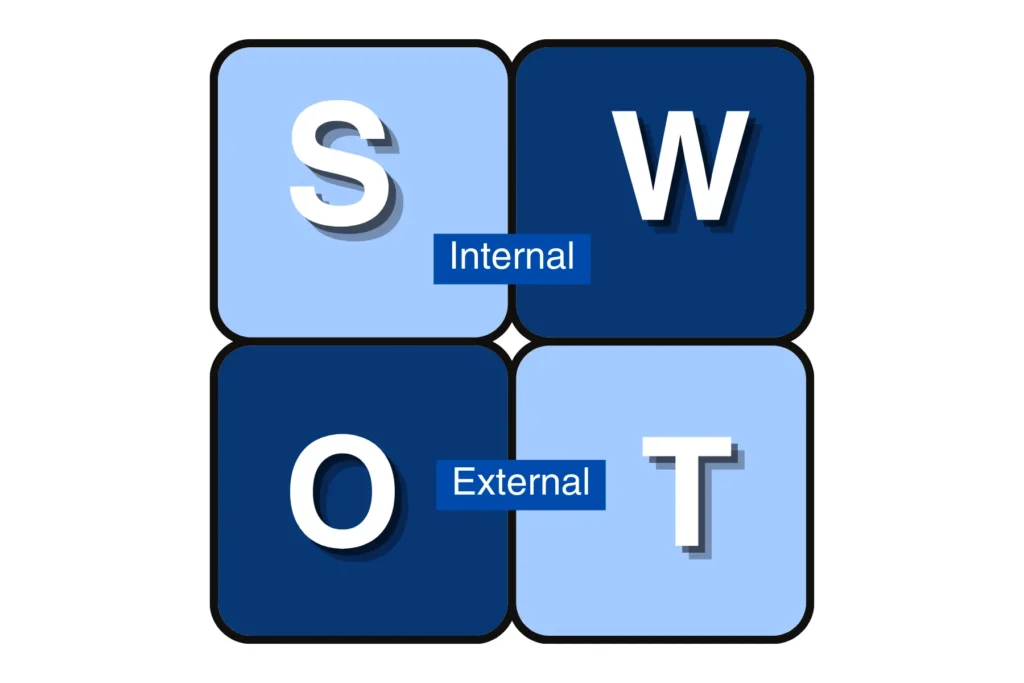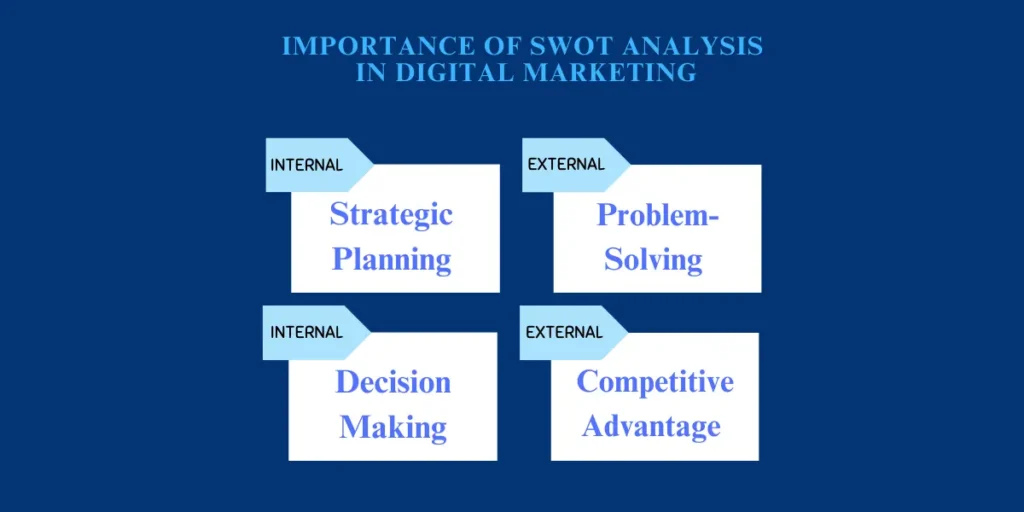Table of Contents
ToggleA strategic planning method called a SWOT analysis is used to determine the opportunities, threats, weaknesses, and strengths of an organization.
It began as a framework for business strategy at Stanford University in the 1960s and 1970s, and it has since spread internationally.
A SWOT analysis’s primary goal is to assist firms in comprehending their internal and external environments.
Businesses may make wise judgments, create winning strategies, and maintain their competitiveness in the market by examining the four components.
Because SWOT Analysis offers a systematic and clear way to assess a company’s present state and prospects, it is especially important in strategic planning.
What is SWOT Analysis?

SWOT Analysis is a strategic tool that helps businesses understand their Strengths, Weaknesses, Opportunities, and Threats.
By conducting a SWOT Analysis, companies can develop a clear picture of their strategic position.
This tool is essential for making informed decisions, planning effectively, and ensuring long-term success.
Here’s a breakdown of each component:
1. Strengths
Strengths are important because they allow companies to build on their advantages and maintain a competitive edge.
These are the internal attributes that give a company an edge over its competitors.
A solid brand reputation, loyal customers, and innovative technology are a few examples.
To identify strengths, businesses can look at what they do well and what sets them apart from others.
2. Weaknesses
These are internal factors that hinder a company’s performance.
Examples include a lack of resources, poor location, and outdated technology. Identifying weaknesses involves examining areas where the company is underperforming.
Addressing and improving weaknesses is crucial because it helps the business enhance its efficiency and competitiveness.
Turn Digital Challenges into Opportunities!
Struggling with competition or ever-changing trends? Let Vicino guide you with customized solutions to stay ahead in the digital game.
Add Your Heading Text Here
3. Opportunities
These are external factors that a company can exploit to its advantage.
Emerging markets, technology developments, and shifts in consumer behavior are a few examples.
To identify opportunities, businesses need to analyze market trends and external environments.
Making the most of growth possibilities is essential since it allows businesses to grow and innovate.
4. Threats
These are external challenges that could negatively impact a company’s performance.
New competitors, recessions, and changes in regulations are a few examples.
Keeping up with market and industry developments is necessary for danger identification.
Risk management is essential since it helps organizations handle possible difficulties.
Importance of SWOT Analysis in Digital Marketing

SWOT Analysis is a vital tool in digital marketing.
It aids in strategic planning, informed decision-making, and gaining a competitive advantage.
By regularly conducting SWOT Analysis, businesses can navigate the digital landscape more effectively and achieve long-term success.
SWOT Analysis is crucial for businesses, especially in digital marketing.
Here’s why –
1. Strategic Planning
SWOT Analysis helps in setting realistic goals and objectives.
By understanding strengths, weaknesses, opportunities, and threats, companies can develop effective strategies that are aligned with their capabilities and market conditions.
This ensures that the business goals are achievable and strategically sound.
2. Decision Making
In digital marketing, making informed and data-driven decisions is important.
SWOT Analysis provides a clear picture of the internal and external factors affecting the business.
This helps in prioritizing resources and efforts where they are most needed, ensuring that decisions are based on a thorough understanding of the situation.
3. Problem-Solving
Developing focused solutions requires determining the underlying causes of problems.
The SWOT analysis aids in identifying potential problem areas, such as weaknesses and threats.
Businesses can take targeted steps to overcome obstacles and boost performance by addressing these areas.
4. Competitive Advantage
By using a SWOT analysis to understand your market position, firms can capitalize on opportunities and strengthen their positions.
You can remain ahead of the competition by capitalizing on your strengths and pinpointing opportunities for expansion.
This study helps in developing plans that make the most of your special assets, giving you a significant competitive advantage.
How to Conduct a SWOT Analysis of Digital Marketing?
Conducting a SWOT Analysis for digital marketing is straightforward and highly beneficial.
Here’s a simple step-by-step guide:
Step: 1 – Gather Relevant Data and Information
Start by collecting all the necessary data about your digital marketing efforts. This includes performance metrics, customer feedback, market trends, and competitor analysis.
Step: 2 – Brainstorm with Stakeholders
Conduct a brainstorming session with important team members and consumers. This guarantees that all important factors are taken into account and helps to obtain a variety of ideas.
Step: 3 – Create the SWOT Matrix
Divide a sheet into four quadrants, labeling them Strengths, Weaknesses, Opportunities, and Threats. List down the points identified during brainstorming in the respective quadrants.
Step: 4 – Analyze and Prioritize Findings
Examine the SWOT matrix to identify the most important areas. Prioritize the points based on their impact on your digital marketing strategy. Focus on leveraging strengths, addressing weaknesses, and seizing opportunities.
Ready to use SWOT analysis to boost your digital marketing?
Tell us your story and see how Vicino can support you.
Our strategic planning and consulting services are tailored to empower startups and emerging businesses to reach their goals.
Contact us now to start your journey with innovative marketing solutions designed for you.
Tools and Techniques
SWOT Templates and Software: Use readily available SWOT templates and software to organize your analysis efficiently.
These tools often provide a structured format to ensure no critical element is overlooked.
Using Surveys and Interviews: Collect insights from customers, employees, and other stakeholders through surveys and interviews.
Their feedback can reveal valuable strengths and weaknesses.
Competitive Analysis Tools: Make use of competitive analysis tools for information about the strategies used by your competitors.
This can help identify opportunities and threats in the market.
Applications of SWOT Analysis

1. Business and Marketing
SWOT analysis is a crucial tool in business for assessing ideas for new products and strategies for effectively entering markets.
It assists in identifying opportunities such as new markets or trends, risks such as competition or economic shifts, and strengths such as special qualities or skills, weaknesses such as resource gaps.
In terms of branding, it directs strategies by stressing the advantages and disadvantages of the brand as well as chances for collaboration or new markets as well as risks like shifting customer preferences or competing pressures.
2. Personal Development
SWOT analysis in career planning evaluates strengths, weaknesses, opportunities, and threats.
It helps individuals identify areas to grow personally and professionally.
It also helps with self-evaluation by pointing out one’s advantages and disadvantages, areas for improvement, and possible roadblocks.
3. Nonprofit and Public Sector
A practical tool for strategizing and improving outcomes in these sectors, SWOT analysis is beneficial to nonprofits and the public sector in many ways.
For program development and evaluation, it helps identify strengths, weaknesses, opportunities, and threats.
It helps organizations plan better and use resources wisely. In policy-making, it ensures decisions consider all angles, leveraging strengths and opportunities while minimizing weaknesses and threats.
In community projects, it guides effective planning, ensuring projects meet community needs and are long-lasting.
Common Pitfalls to Avoid

Avoiding frequent errors is important for accurate insights and successful plan implementation when performing a SWOT analysis for digital marketing.
1. Bias and Subjectivity
Maintaining objectivity is paramount.
It’s vital to base your analysis on factual data rather than personal biases.
Engage diverse perspectives within your team to gain a more balanced view of strengths, weaknesses, opportunities, and threats.
2. Overlooking External Factors
A thorough SWOT analysis shouldn’t focus solely on internal aspects.
Consider external factors such as market trends and competitor activities.
Regularly update your analysis to adapt to evolving industry dynamics.
Conclusion
In conclusion, SWOT analysis proves invaluable for digital marketing strategies.
It offers a clear view of strengths, weaknesses, opportunities, and threats, guiding effective decision-making.
SWOT analysis enables businesses to capitalize on strengths, address weaknesses, seize opportunities, and prepare for threats.
It fosters informed strategies that align with business goals and market conditions.
I encourage incorporating SWOT analysis not only in digital marketing but across various business aspects.
It provides a structured approach to understanding competitive positioning and fostering innovation.
Looking ahead, the evolution of digital marketing calls for adapting SWOT analysis to include emerging technologies, consumer behavior shifts, and global market dynamics.
Continuous updates and integration with data analytics will enhance its relevance and effectiveness.
By leveraging SWOT analysis, businesses can navigate the complexities of digital marketing with confidence, ensuring sustainable growth and competitive advantage in an ever-changing landscape.
FAQ’s
1. What is a SWOT analysis in digital marketing?
SWOT analysis in digital marketing involves evaluating a business’s Strengths, Weaknesses, Opportunities, and Threats within the digital space. This strategic tool helps identify areas to capitalize on and challenges to address for better campaign results.
2. How can SWOT analysis improve my digital marketing strategy?
By identifying internal strengths and weaknesses, as well as external opportunities and threats, SWOT analysis provides actionable insights. This allows businesses to allocate resources effectively, target the right audience, and adapt to changing market trends.
3. What are examples of strengths in digital marketing SWOT analysis?
Strengths could include a high-performing website, a loyal customer base, a strong social media presence, or expertise in search engine optimization (SEO) and paid advertising.
4. How can a business address its weaknesses in digital marketing?
Businesses can overcome weaknesses, such as low website traffic or poor audience engagement, by investing in analytics tools, improving content quality, or leveraging expert services like SEO and social media management.
5. Why is it important to analyze threats in digital marketing?
Analyzing threats helps businesses prepare for external challenges, such as competitor strategies, changing algorithms, or shifts in consumer behavior. Being proactive ensures your marketing efforts remain effective and adaptable.





